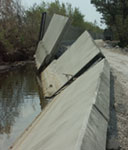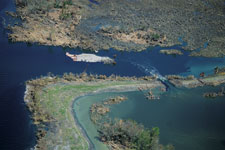 |
St. Bernards 13 miles of 17 to 17.5-ft-high earthen outer levees along the Mississippi River Gulf Outlet were breached in several places, including one measuring several thousand feet. That sent a torrent into the neighborhood that produced "complete destruction" and swept houses from their foundations, says Col. Duane P. Gapinski, the Corps officer charged with dewatering New Orleans. No residents will be allowed back in the parish for four months and the levee "will take a lot longer than four months to repair," says Gapinski.
 |
| Paralyzed Parish. Flood-strewn refuse creates cleanup nightmare that is toxic and may require weeks to clean. |
It is still too early for investigators to offer a definitive explanation of how flood defenses failed. Corps engineers are puzzling over forensic details and weighing various failure theories.
Lt. Gen. Carl V. Strock last week mused during a briefing at the Corps district office in New Orleans about possible contributing factors, such as the timing of power loss and the performance of the citys drainage pump system. The questions are especially relevant as critics of the Corps question its priorities and use of resources in the region.
For the moment, examining the broader issues is a luxury frontline Corps officers cant afford. In addition to dewatering and repairing damaged storm protections, Corps officials must be careful to protect the health of workers as sludge and potentially toxic sediment are exposed.
As of Sept. 12 the "unwatering" was "going very well in certain areas," particularly in the hard-hit East Orleans and St Bernard Parish, both east of center city, Gapinski says. He says the work is "picking up steam" in Orleans Parish, where floodwaters are gradually drawing back toward Lake Pontchartrain bordering the north side of town. He says a lack of mobility and communications issues have kept the Corps from getting into lower Plaquemine Parish sooner.
Gapinski predicts that at the current rate and barring another storm, water will be gone from Orleans, East Orleans and St. Bernard parishes by Oct. 8 and from Plaquemine Parish 10 days later.
There are other hard-hit areas. Near total devastation extends 45 miles from the community of Port Sulphur, about 35 miles below New Orleans, to Venice, near the rivers mouth. High water is trapped in a narrow, community-dotted strip of land between the river levee and a back-levee built after Hurricane Camille in 1969 to block storm surge from the southwest. There are at least two severe breaches, one on the river and one adjacent to a pump station on the back levee. Virtually every building in the strip has been floated off its foundations, knocked to pieces or otherwise destroyed. "There are neighborhoods, small towns, where all you see is foundations and houses pushed up against the outer levee, pushed up against each other or just in pieces," Gapinski says.
Drawing Conclusions
 |
| Fallen floodwall panels at London Ave. breach . (Photo by Andrew G. Wright for ENR) |
As the bigger picture of the damage came into focus, it showed multiple breaches in New Orleans eastern and southeastern defenses. Most were caused by the storm but in a few places the levees have been "notched" intentionally to relieve the flood. Among the most serious storm breaches are three in Orleans Parish. One failure occurred in a floodwall-topped levy that boxes in the 17th Street Canal.
A few blocks to the east two similar levy/wall structures channeling the London Avenue Canal also failed, one on the east and one on the west side. One detail being eyed is an apparent 20-ft shift of a levee section and floodwall on the London Avenue Canal, about 20 ft to the west of an area where one of the breaches occurred. The chances of finding a witness to the event are slim. "Anybody who saw that is probably dead," says Al Naomi, senior project manager of the Corps Lake Pontchartrain and Vicinity Hurricane Protection Project. "This is something thats going to take a long time to understand." ![]() click here to view | diagram | map |
click here to view | diagram | map |
The levee breaks may have sealed the citys fate but engineers say the true culprit may have been a massive sheet-flow of water that overtopped the levees of the citys northern and eastern reaches. Witnesses are few and the forensic evidence is still, for the most part, under the flood.
"Its very hard to be definitive about much except what you have seen with your own eyes," says Naomi. "But we had a lockmaster who watched the water overtop the floodwalls. I dont think he saw the breaches, but he reported during the event that massive quantities of water was pouring over those walls."
Analyzing the mechanics of the disaster will take much more than scanty evidence drawn from any single point of failure. "Anybody who wants to make definitive statement right now is walking on dangerous ground," Naomi says.
Draining the water is a campaign fought in dozens, perhaps hundreds of daily skirmishes, each with their own setbacks and ups and downs. Contractors are struggling to plug levees in all four of the most heavily affected drainage basinsOrleans, East Orleans, St. Bernard and Plaquemine. In some cases that means spending days building roads across the flood just to get to the trouble spot, while helicopters bomb the inaccessible holes with sandbags.
Matthew Fedowitz, site supervisor on the levee breach-closing project on the London Canal for local Boh Bros. Construction Co., says his crew is extraordinarily motivated to work fast because many lost homes in the flood. "We built 750 ft [of road] last night," Fedowitz said as a string of 20-ton dump trucks picked their way along a one-lane road being built on the backside of the west levee. Tiny turnouts allow the trucks to shuttle in and out as they drop alternating loads of 12-in. rock and tons of gravel for surfacing. A dozer darts out from another turnout in between truck passes to spread the rock and gravel and extend the road. The path will go down the levee, across a bridge and back up the other side to get to a deep, long breach.
 |
| Legacy System. Motors of New Orleans pumping stations need two weeks to dry out. |
Electricians and mechanics are working at sites all over the flooded city, furiously draining and drying out municipal pumping stations, generators, motors and electronic controls at dozens of sites every day. They are trying to restart the citys 148-pump system, while distributing portable pumps and generators by truck and barge, from spot to spot, in a scramble to get water out fast.
The below-sea-level citys drainage system depends on a system of installed pumps to lift the water to outfalls. Some outfalls dump their charges where the edge of town meets Lake Pontchartrain or into other surrounding bodies of water. Other pumps are sited deep in the city and empty into open canals that lead to the lake. Levees that lined two of those canals failed, a big part of the disaster.
 |
| Cleanup. Excavators clear massive amounts of debris at Pump 15 Intake Canal . |
The interior pumps include the oldest parts of the system but have the highest volume outputs, up to 1,200 cfs each. Pump station No. 6, which has 15 pumps, can move up to 10,000 cfs alone. The old pumps are powered by simple, direct-drive 25-Hz electric motors that turn impellers in pipes with diameters of 10, 12 or 14 ft. A dedicated 60-MW generator plant of similar vintage supplies power. Twenty-five Hz was chosen because it turns the impeller at 80 to 90 rpm, the optimum speed for moving large water volumes without need for gears or other regulation, say officials.
Most of the pump stations house multiple pumps, and the newer pumps run on standard 13.2-kV, 60-Hz power. But even today, the really high-volume pumps are the old timers, and they depend on the 25-Hz feeder circuit. The 25-Hz generator plant was dried out and back in business by Sept. 11. "But we dont have many pumps ready to take it yet," says Gapinski. "The motors are not ready they have to bake them."
 |
| Compromised. Levees south of New Orleans along Mississippi River took damage. |
Baking is a matter of heating the equipment to dry out water. Two somewhat newer 25-Hz, 1,000-cfs pumps that were sealed have been returned to operation. The others, unsealed and wet, need another 10 days to dry, Gapinski says.
"The city needs sealed pumps," says Maj. George Stejic, who is pushing the pump restoration project. He also is pulling in high-capacity generators to get more of the other, 60-Hz pumps back on line. But again, every effort is a battle.
For instance, a crew from Flowserve Corp, Irving, Texas, pulled into town Sept. 9 after a five-day haul from Saginaw, Mich., with a convoy of eight lowboy trailers loaded with generators, including two 2-MW monsters. Overall, they can generate 11 MW, enough to power a town of 30,000 people.
But there were problems. The amperage of the two largest generators didnt match that needed for the citys pumps. And the Flowserve crew found themselves hung in a logistical disconnect that left them sitting on a dock for days awaiting a crane and barges to get them to their destinations. "Theyre still sitting on the dock," Stejic sighed Sept. 11. "Were having trouble getting the barges, but well have a crane ready Monday."
(Photos by Michael Goodman for ENR)
sobering new reality has emerged in sodden New Orleans as floodwaters recede and a tireless recovery effort shows gains. The damage to the regions flood defenses is worse than previously believed, say officials of the Army Corps of Engineers, stretching for miles in badly damaged St. Bernard Parish and leaving the region especially vulnerable to new storms.
Post a comment to this article
Report Abusive Comment